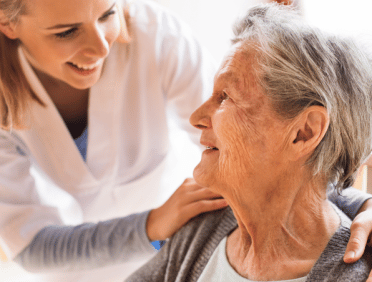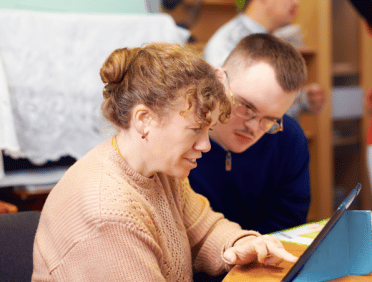Safeguarding Adults at Risk: Physical Abuse
Physical abuse of vulnerable adults or those at risk of harm is a serious issue that can have devastating consequences for its victims. As individuals and as a society, it is our duty to prevent harm, reduce the risk of abuse or neglect to adults with care and support needs, and ensure that those who experience abuse are provided with the support and resources they need to recover.
In this blog, we will explore what physical abuse is according to safeguarding policy, how safeguarding relates to physical health, the Care Act 2014 and its relevance to safeguarding adults, and how to recognise adult abuse, with a particular focus on assault, hitting, inappropriate physical sanctions, misuse of medication, pushing, restraint, and slapping.
What is physical abuse according to safeguarding policy?
Physical abuse is a form of abuse that involves the use of physical force to cause harm or injury to the victim. It can take many forms, including hitting, slapping, pushing, restraint, and the inappropriate use of physical sanctions. Physical abuse can cause significant physical and emotional harm to the victim, including physical injuries, trauma, and anxiety.
According to safeguarding policy, physical abuse is any act or omission that results in physical harm or the risk of physical harm to an adult with care and support needs. This can include deliberate harm, neglect, or failure to provide adequate care or support.
Physical abuse can occur in any setting, including the home, care homes, hospitals, and other care settings. It can also be perpetrated by anyone, including family members, friends, or professionals who are responsible for the care and support of vulnerable adults.
How does safeguarding relate to physical health?
Safeguarding is essential for protecting the physical health and well-being of vulnerable adults. Physical abuse can cause significant physical harm, including injuries, fractures, and other health problems that can impact the victim’s quality of life.
In addition to the physical harm caused by abuse, victims may also experience emotional and psychological harm, including depression, anxiety, and post-traumatic stress disorder (PTSD). Safeguarding is therefore essential for protecting the physical and mental health of vulnerable adults and ensuring that they are provided with the support and resources they need to recover from the abuse.
The Care Act 2014 (safeguarding adults)
The Care Act 2014 is the primary legislation governing adult social care in England and includes provisions for safeguarding adults at risk of harm. The Act sets out the duties and responsibilities of local authorities, care providers, and other organisations in relation to safeguarding adults at risk.
Under the Act, local authorities have a duty to make inquiries if they have reason to believe that an adult with care and support needs is at risk of abuse or neglect. They also have a duty to take appropriate action to protect the adult from harm and provide them with the support and resources they need to recover.
The Act also includes provisions for multi-agency working, information-sharing, and the involvement of the adult at risk in safeguarding processes. It emphasises the importance of a person-centered and outcome-focused approach to safeguarding adults at risk.
Recognising adult abuse
Recognising adult abuse is essential for safeguarding vulnerable adults and preventing further harm. In the context of physical abuse, some signs and indicators of abuse may include:
Assault
assault involves the use of physical force to cause harm or injury to the victim. This may include hitting, kicking, punching, or using weapons to harm the victim. The use of physical force to intimidate or threaten the victim may also be considered assault. Signs of assault may include unexplained bruises, cuts, or other injuries, as well as changes in the victim’s behavior or personality.
Assault can take many forms and may not always leave visible physical injuries. For example, verbal assault or threats can be just as damaging to the victim’s emotional and psychological well-being. It is important to recognise the signs and indicators of assault to safeguard vulnerable adults and take appropriate action to protect them from harm.
When recognising assault, it is important to approach the situation with sensitivity and compassion. Victims of assault may feel ashamed or embarrassed and may be hesitant to speak out about their experiences. It is essential to listen to their concerns and take their allegations seriously, while also providing them with emotional support and resources to help them recover from their experiences.
Reporting assault to the appropriate authorities is essential for safeguarding vulnerable adults and ensuring that perpetrators are held accountable for their actions. This may involve reporting to social services, the police, or other agencies responsible for safeguarding vulnerable adults. It is important to remember that reporting abuse is not always easy, but it is essential for protecting the physical and emotional well-being of vulnerable adults and preventing further harm.
Hitting
Hitting is the use of physical force to cause harm or injury to the victim. This may include striking the victim with an open hand or a closed fist, using objects to hit the victim, or hitting the victim with a part of the body. Signs of hitting may include unexplained bruises, cuts, or other injuries, as well as changes in the victim’s behavior or personality.
Hitting can take many forms and may not always leave visible physical injuries. For example, hitting may involve using excessive force during personal care tasks, such as bathing or dressing, that can cause physical harm or injury to the victim. It is important to recognise the signs and indicators of hitting to safeguard vulnerable adults and take appropriate action to protect them from harm.
When recognising hitting, it is important to approach the situation with sensitivity and compassion. Victims of hitting may feel ashamed or embarrassed and may be hesitant to speak out about their experiences. It is essential to listen to their concerns and take their allegations seriously, while also providing them with emotional support and resources to help them recover from their experiences.
Reporting hitting to the appropriate authorities is essential for safeguarding vulnerable adults and ensuring that perpetrators are held accountable for their actions. This may involve reporting to social services, the police, or other agencies responsible for safeguarding vulnerable adults. It is important to remember that reporting abuse is not always easy, but it is essential for protecting the physical and emotional well-being of vulnerable adults and preventing further harm.
Inappropriate physical sanctions
Misuse of medication
Inappropriate physical sanctions is the use of physical punishment or discipline that is excessive or inappropriate. This may include hitting, slapping, or other forms of physical punishment that are not appropriate for the situation. Signs of inappropriate physical sanctions may include unexplained bruises, cuts, or other injuries, as well as changes in the victim’s behavior or personality.
Inappropriate physical sanctions may also involve the use of excessive exercise or physical labor as punishment, or the withholding of food or water as a form of discipline. It is important to recognise the signs and indicators of inappropriate physical sanctions to safeguard vulnerable adults and take appropriate action to protect them from harm.
When recognising inappropriate physical sanctions, it is important to approach the situation with sensitivity and compassion. Victims of inappropriate physical sanctions may feel ashamed or embarrassed and may be hesitant to speak out about their experiences. It is essential to listen to their concerns and take their allegations seriously, while also providing them with emotional support and resources to help them recover from their experiences.
Reporting inappropriate physical sanctions to the appropriate authorities is essential for safeguarding vulnerable adults and ensuring that perpetrators are held accountable for their actions. This may involve reporting to social services, the police, or other agencies responsible for safeguarding vulnerable adults. It is important to remember that reporting abuse is not always easy, but it is essential for protecting the physical and emotional well-being of vulnerable adults and preventing further harm.
Pushing
In the context of physical abuse, pushing involves the use of physical force to push the victim, which can cause harm or injury. This may include pushing the victim down stairs or into walls, or pushing them forcefully enough to cause physical harm. Signs of pushing may include unexplained bruises, cuts, or other injuries, as well as changes in the victim’s behavior or personality.
Pushing can take many forms, and may be part of a pattern of controlling or abusive behavior. It is important to recognise the signs and indicators of pushing to safeguard vulnerable adults and take appropriate action to protect them from harm.
It is important to approach any pushing situation with sensitivity and compassion. Victims of pushing may feel frightened or traumatised, and may not be willing to speak out about their experiences. It is essential to listen to their concerns and take their allegations seriously, while also providing them with emotional support and resources to help them recover from their experiences.
Reporting pushing to the appropriate authorities is essential for safeguarding vulnerable adults and ensuring that perpetrators are held accountable for their actions. This may involve reporting to social services, the police, or other agencies responsible for safeguarding vulnerable adults. It is important to remember that reporting abuse is not always easy, but it is essential for protecting the physical and emotional well-being of vulnerable adults and preventing further harm.
Restraint
Restraint is the use of physical force to restrict the movement of the victim, which can cause harm or injury. This may include tying the victim to a chair or bed, or using physical force to hold them down or prevent them from leaving a room. Signs of restraint may include marks on the victim’s wrists or ankles, as well as changes in the victim’s behavior or personality.
Restraint can be particularly dangerous for vulnerable adults who may have underlying health conditions or mobility issues. The inappropriate or excessive use of restraint can cause physical harm or injury, and can also be emotionally traumatic for the victim. It is important to recognise the signs and indicators of restraint to safeguard vulnerable adults and take appropriate action to protect them from harm.
Victims of restraint may feel frightened or traumatised, and may not be willing to speak out about their experiences. It is essential to listen to their concerns and take their allegations seriously, while also providing them with emotional support and resources to help them recover from their experiences.
Reporting restraint to the appropriate authorities is essential for safeguarding vulnerable adults and ensuring that perpetrators are held accountable for their actions. This may involve reporting to social services, the police, or other agencies responsible for safeguarding vulnerable adults. It is important to remember that reporting abuse is not always easy, but it is essential for protecting the physical and emotional well-being of vulnerable adults and preventing further harm.
Slapping
Slapping involves the use of physical force to strike the victim with an open hand, which can cause harm or injury. Signs of slapping may include unexplained bruises, cuts, or other injuries, as well as changes in the victim’s behavior or personality.
Slapping can be part of a pattern of controlling or abusive behavior, and may have a significant impact on the victim’s emotional well-being. It is important to recognise the signs and indicators of slapping to safeguard vulnerable adults and take appropriate action to protect them from harm.
When recognising slapping, it is important to approach the situation with sensitivity and compassion. Victims of slapping may feel ashamed or embarrassed, and may be hesitant to speak out about their experiences. It is essential to listen to their concerns and take their allegations seriously, while also providing them with emotional support and resources to help them recover from their experiences.
Reporting slapping to the appropriate authorities is essential for safeguarding vulnerable adults and ensuring that perpetrators are held accountable for their actions. This may involve reporting to social services, the police, or other agencies responsible for safeguarding vulnerable adults. It is important to remember that reporting abuse is not always easy, but it is essential for protecting the physical and emotional well-being of vulnerable adults and preventing further harm.
Safeguarding of Adults Training
- Learn Q’s Safeguarding Adults Level 1 is an introductory course that provides a basic understanding of safeguarding vulnerable adults. It covers the concept of safeguarding, the importance of safeguarding, the legislation in place to protect vulnerable adults, the signs of abuse and how to avoid them, and how to respond when a vulnerable adult discloses they are being abused or neglected. This course is suitable for anyone who works with vulnerable adults, including managers, supervisors, employees, and volunteers at all levels.
- Learn Q’s Safeguarding Adults Level 2 course, on the other hand, is a more advanced course that builds on the knowledge gained in Level 1. It provides a more in-depth understanding of safeguarding, including recognising abuse, the responsibilities of different safeguarding roles, effective communication, and how to handle concerns and incidents related to safeguarding. This course is designed for those with additional safeguarding responsibilities, such as those who work in hospitals, general practices, nursing homes, care homes, or domiciliary care, as well as in religious organisations and community organisations.
Overall, while both courses cover the essential knowledge and skills needed to safeguard vulnerable adults, Safeguarding Adults Level 2 provides a more comprehensive and detailed understanding of safeguarding, which is important for those who have additional safeguarding responsibilities.
These courses are ideal for those who work in hospitals, general practices, nursing homes, care homes, domiciliary care, as well as in religious and community organisations. By completing this course, you will be better equipped to handle safeguarding concerns and to ensure the safety and well-being of vulnerable adults.
At Learn Q, we are committed to providing high-quality training that meets the needs of professionals across a range of industries. Our Safeguarding Adults courses are designed to provide you with the knowledge and skills you need to excel in your role and make a real difference in the lives of vulnerable adults. Sign up today and take the next step in your career!
Conclusion
Physical abuse of vulnerable adults is a serious issue that can have significant physical and emotional consequences for its victims. Safeguarding is essential for protecting the physical and emotional well-being of vulnerable adults and ensuring that they are provided with the support and resources they need to recover from abuse.
Recognising the signs and indicators of physical abuse is essential for safeguarding vulnerable adults and taking appropriate action to protect them from harm. It is also essential that professionals who work with vulnerable adults receive regular and up-to-date training to ensure that they are equipped with the knowledge and skills they need to identify and respond to adult abuse.
By working together, we can help to prevent physical abuse and ensure that vulnerable adults are able to live their lives free from harm and abuse.
To download a .pdf of this blog, please click here












